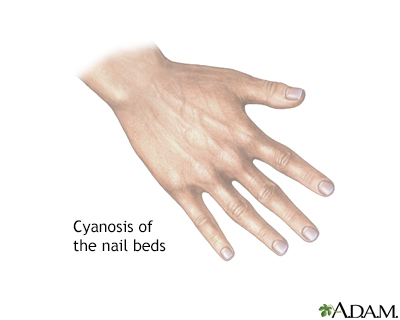Blue discoloration of the skin
Definition
A bluish color to the skin or mucous membrane is usually due to a lack of oxygen in the blood. The medical term is cyanosis.
Alternative Names
Lips - bluish; Fingernails - bluish; Cyanosis; Bluish lips and fingernails; Bluish skin
Considerations
Red blood cells provide oxygen to body tissues. Most of the time, nearly all red blood cells in the arteries carry a full supply of oxygen. These blood cells are bright red and the skin is pinkish or red.
Blood that has lost its oxygen is dark bluish-red. People whose blood is low in oxygen tend to have a bluish color to their skin. This condition is called cyanosis.
Depending on the cause, cyanosis may develop suddenly, along with shortness of breath and other symptoms.
Cyanosis that is caused by long-term heart or lung problems may develop slowly. Symptoms may be present, but are often not severe.
When the oxygen level has dropped only a small amount, cyanosis may be hard to detect.
In dark-skinned people, cyanosis may be easier to see in the mucous membranes (lips, gums, around the eyes) and nails.
People with cyanosis do not normally have anemia (low blood count). Anemia is a condition in which the body does not have enough healthy red blood cells.
Causes
Cyanosis that is seen in only one part of the body may be due to:
- A blood clot that blocks the blood supply to a leg, foot, hand, or arm
- Raynaud phenomenon (condition in which cold temperatures or strong emotions cause blood vessel spasms, which block blood flow to the fingers, toes, ears, and nose)
LACK OF OXYGEN IN THE BLOOD
Most cyanosis occurs because of a lack of oxygen in the blood. This can be caused by the following problems.
Problems with the lungs:
- Blood clot in the arteries of the lungs (pulmonary embolism)
- Drowning or near-drowning
- High altitude
- Infection in the smallest air passages in the lungs of children, called bronchiolitis
- Long-term lung problems that become more severe, such as chronic obstructive pulmonary disease (COPD), asthma, and interstitial lung disease
- Pneumonia (severe)
Problems with the airways leading to the lungs:
- Breath-holding (although this is exceedingly difficult to do)
- Choking on something stuck in the airways
- Swelling around the vocal cords (croup)
- Inflammation of the flap of tissue, called the epiglottis, that covers the windpipe (epiglottitis)
Problems with the heart:
- Heart defects that are present at birth (congenital)
- Heart failure
- Heart stops working (cardiac arrest)
Other problems:
- Drug overdose (narcotics, benzodiazepines, sedatives)
- Exposure to cold air or water
- Seizure that lasts a long time
- Toxins such as cyanide
Home Care
For cyanosis caused by exposure to cold or Raynaud phenomenon, dress warmly when going outside or stay in a well-heated room.
When to Contact a Medical Professional
Bluish skin can be a sign of many serious medical problems. Call or visit your health care provider.
For adults, contact your doctor or call the local emergency number, such as 911 if you have bluish skin and any of the following:
- You cannot get a deep breath or your breathing is getting harder, or faster
- Need to lean forward when sitting to breathe
- Are using muscles around the ribs to get enough air
- Have chest pain
- Are having headaches more often than usual
- Feel sleepy or confused
- Have a fever
- Are coughing up dark mucus
For children, contact the doctor or call the local emergency number, such as 911 if your child has bluish skin and any of the following:
- Hard time breathing
- Chest muscles moving in with each breath
- Breathing faster than 50 to 60 breaths per minute (when not crying)
- Making a grunting noise
- Sitting with shoulders hunched over
- Is very tired
- Is not moving around much
- Has a limp or floppy body
- Nostrils are flaring out when breathing
- Does not feel like eating
- Is irritable
- Has trouble sleeping
In general, cyanosis that occurs acutely is more likely to be an emergency than when it is present for a long time.
What to Expect at Your Office Visit
Your provider will perform a physical examination. This will include listening to your breathing and heart sounds. In emergency situations (such as shock), you will be stabilized first.
The provider will ask about your symptoms. Questions may include:
- When did the bluish skin develop? Did it begin slowly or suddenly?
- Is your body blue all over? How about your lips or nailbeds?
- Have you been exposed to cold or have you been at a high altitude?
- Do you have trouble breathing? Do you have a cough or chest pain?
- Do you have ankle, foot, or leg swelling?
Tests that may be ordered include:
- Arterial blood gas analysis
- Blood oxygen saturation by pulse oximetry
- Chest x-ray
- Chest CT scan
- Complete blood count (CBC)
- Electrocardiogram (ECG)
- Echocardiogram (ultrasound of the heart)
The treatment you receive depends on the cause of cyanosis. For example, you may receive oxygen for shortness of breath.
Gallery

References
Fernández-Frackelton M. Cyanosis. In: Walls RM, Hockberger RS, Gausche-Hill M, eds. Rosen's Emergency Medicine: Concepts and Clinical Practice. 9th ed. Philadelphia, PA: Elsevier; 2018:chap 11.
McGee S. Cyanosis. In: McGee S, ed. Evidence-Based Physical Diagnosis. 5th ed. Philadelphia, PA: Elsevier; 2022:chap 9.